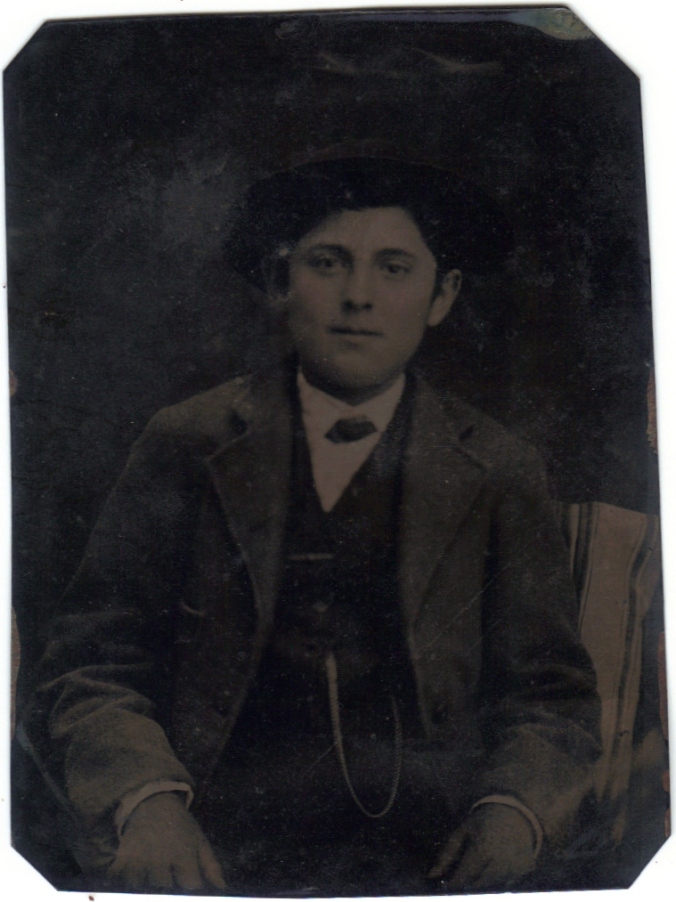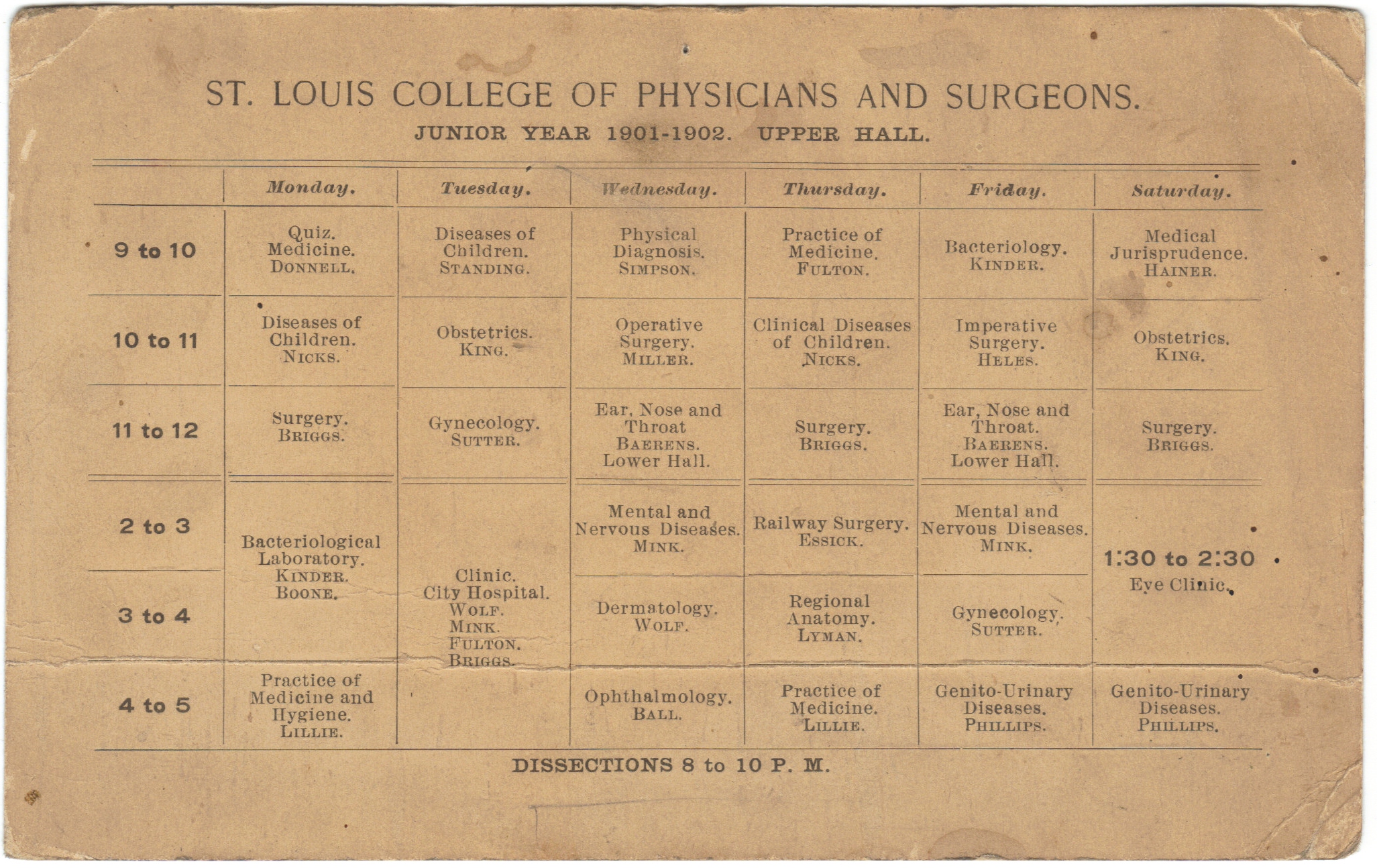Kromer Columbus Ice
Montgomery Church of Christ, Montgomery, West Virginia, ca. 1920
In about 1907-1908 K. C. Ice preached for this congregation, known both as Montgomery Christian Church and Montgomery Church of Christ. I suspect this building was the same one in which he preached.* This card was posted December 21, 1921.
*Update: My hunch is incorrect. Google Maps street view offers a clear view of the cornerstone which suggests the congregation began in 1897 and this building was completed in 1916.
Reading afterwhile: K. C. Ice’s marginalia in a second-hand copy of William Jay
I am trying to reengage a writing habit here. Please forbear while I stretch and work out the kinks.
I am almost always reading, and usually in old Restoration Movement material. I cannot fathom another way if I want to claim with integrity to be a librarian, archivist, and bibliographer of the Stone-Campbell Movement. As a diversion I enjoy mining my library for the traces left by earlier readers. I especially like to read after my forebears by looking for the marginalia left by K. C. Ice, or M. C. Ice, or R. D. Ice. Just so happens that is often in other old Restoration material. If my diversion leads to the English Bible, it could just as often be one owned and used by Rosa B. Sandige Ice.
K. C. Ice assembled a Restoration library, to which his son (my grandfather) added, and to which his son (my uncle) added, all of which I inherited and to which I have added my own. K. C. Ice had a distinctive manner of marking sentences or paragraphs using marginal parentheses or brackets. He would sometimes partially underline within the bracketed text, or put a check mark in the margin. Two or more kinds of markings indicate especially noteworthy passages. The exceptional cases merited a parenthetical comment. Grandad and Uncle Rhod also left traces in these same books. While Discipliana was a special interest for all of them, they scrounged for books wherever they could find them, and whatever was of use and within reach found its way to the shelves.
I am unfailingly fascinated when I read after them.
Such is the case here, an odd volume of William Jay K. C. picked up second hand. Upon receipt, he almost always signed and dated his books, then noted where he lived at the time of acquisition. He and Rosa moved several times, and not until I mined his inscriptions in his books did we in the family have a fairly firm grasp of the timeline of some of those moves. Such is about all the trail I had to go on for the decade of 1901-1910, and to a lesser degree 1910-1920 when my grandfather was able to fill-in from his living memory.
Those years, aside from his retirement, were his most active as a reader. He alternated between practicing medicine and holding forth from a pulpit, and at some points both at once. Intake and outgo. He read because Sunday comes every week.
Back to William Jay. In February 1903 K. C. Ice is about to begin his final term at St. Louis College of Physicians and Surgeons, the training and credential from which will be necessary for his intended work (so far as we know) of service as a medical missionary to either China or India under the auspices of the Foreign Christian Missionary Society. That dream did not materialize and I do not definitively know why, but that is another post for another day. But in 1903 all indications suggest he had his eye on a medical mission abroad. Meanwhile he trained for this work in the classrooms and laboratories at the St. Louis college, and in the churches whatsoever would be open to him. I do not know which congregation in St. Louis he attended. But in February 1903 he acquired a copy of William Jay at a Salvation Army store on Franklin Avenue in St. Louis.
Why he later erased part of his last name, but retained his initials, is also anyone’s guess.
Psalm 119.11, in the 1901 American Standard Version, which KC Ice used at this time, reads:
I cannot speak to the origin of the flyer pasted on the front board. It does not read as a product of the Restoration Movement. But it does make quite the use of lyrics of gospel songs, doesn’t it?
Though it lacks its title page, I located the edition online and supply it here:
The scans below contain only a couple of marked passages. There are are such markings throughout. He either read through it at once, or much of it here and there over the years. Possibly both. Look for the marginal parentheses and underlines:
So, what merited his parenthetical note?
Deliver us from the views and dispositions of those who in their self-deception think and live and move and breathe as if in this life they have it all
“Born from above and bound for glory…”
“Rectify all our principles, and give us clear, and consistent, and influential views of divine truth…”
That’s rich.
Traces, sometimes that is all you have. Traces to read afterwhile. Traces which are at once a diversion and a world unto themselves.
Mr. World and Miss Church Member: Katherine Sommer’s edition
A sub-set of my interest in RM bibliography is propaganda novels. I admit it is down the list of my interests, but the whole genre is terrifically obscure…therefore the attraction. Speaking of obscure, should any double-major in English and Theology feel up for the task, I think there is a thesis or dissertation here somewhere. The basic plot line follows the honest truth-seeker who eventually finds enlightenment and along with it…if not coterminous to it…the essence of the ‘Restoration Plea’ (or some sort of moral lesson). Clad in novel form, such documents advance Restoration principles before the reading public in a manner distinct from, but in content similar to, formal debates, doctrinal monographs or theological treatises. The argument comes through the agonist’s experience: as the character finds her way, so too can the reader. I’m working on a short list of RM propaganda novels, to be posted to this site on the 27th.
Mr. World and Miss Church Member is an interesting variation on this theme. One, it is an allegory, and two, W. S. Harris has no Stone-Campbell ties. William Shuler Harris appears to have been quite the character, and modestly prolific at that, as this entry on TomFolio details. Henry Hain, the entry’s author, knows of three editions of Mr. World and Miss Church Member; this one, published by Katherine Way Sommer, is a new one for the list (hers is a printing of the 1902 Holzaphel 3rd edition). If you’d like your own copy, go here to archive.org. So why all this for an allegory whose author appears to have no Stone-Campbell connection? The Sommer family published an edition of it. Katherine Way Sommer, known to her readers as K. W. Sommer, published a major periodical voice among Churches of Christ in its day, Octographic Review, edited by her husband Daniel Sommer. The Sommer family not only published but authored a propaganda novel or two themselves. K. C. Ice more often than not inscribed his books with a signature and date of acquisition. Alas, in this one he did not follow custom. Included is a fly-away clipping from the 19 May 1903 Octographic Review containing praise for Mr. World by one John Harris from Indian Territory.
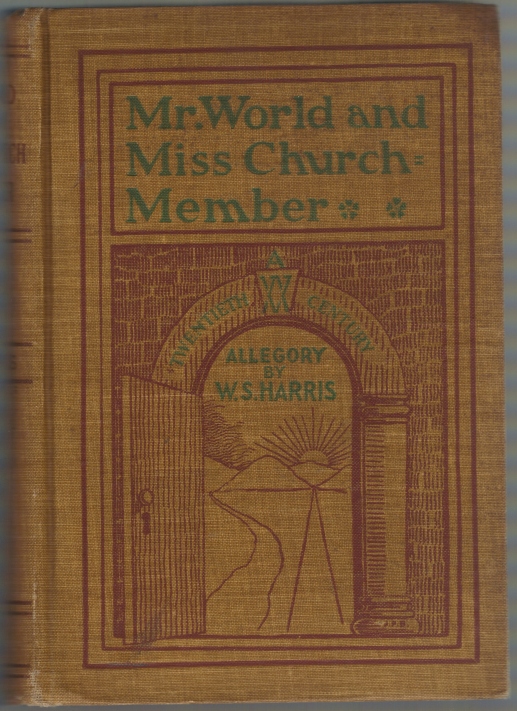




The Millenium and the Second Coming of Christ, A Tract by Ira C. Moore
Ira C. Moore, The Millenium and the Second Coming of Christ, undated tract, about 8.5 x 14 in. folded once; perhaps printed by F. L. Rowe in Cincinnati. K. C. Ice tucked it into an envelope sometime after 9 November 1936, in which envelope it still resides. I assume the typewritten notation at the top of the first page from Moore is to K. C. Ice; I further assume Moore’s forthcoming article was to appear in the pages of Rowe’s Christian Leader, of which Moore was an editor from 1910 until his death in 1938 (inclusive of his editorship of the Christian Leader and The Way).
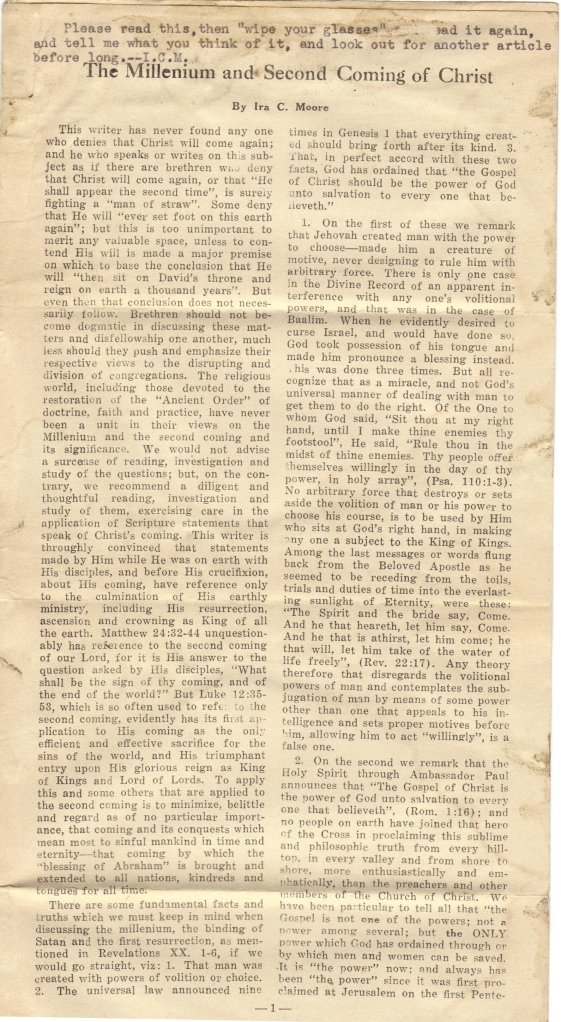
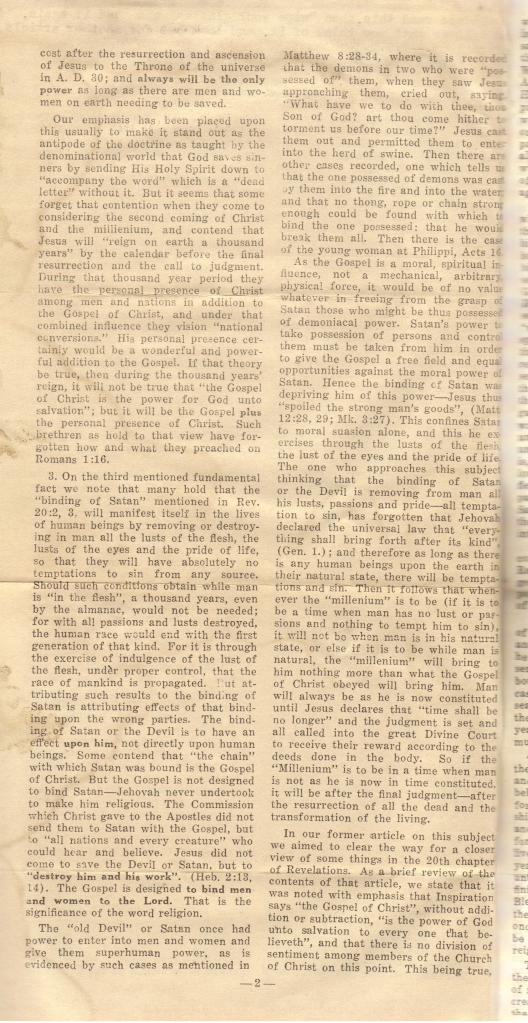
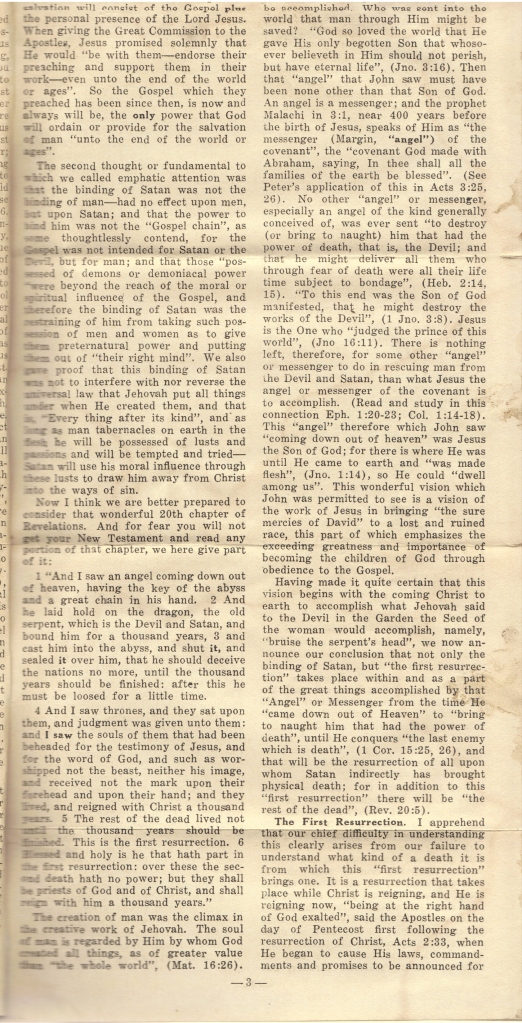
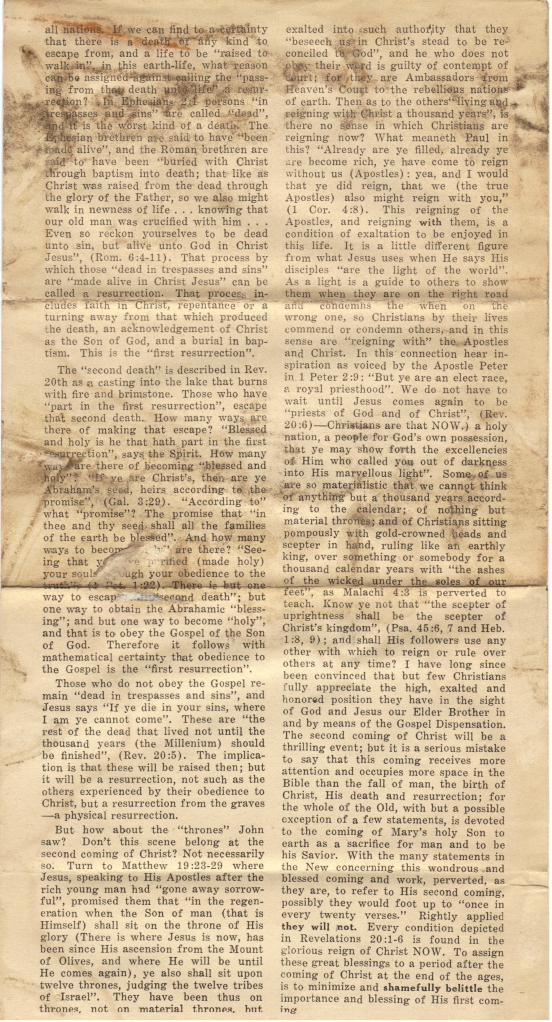
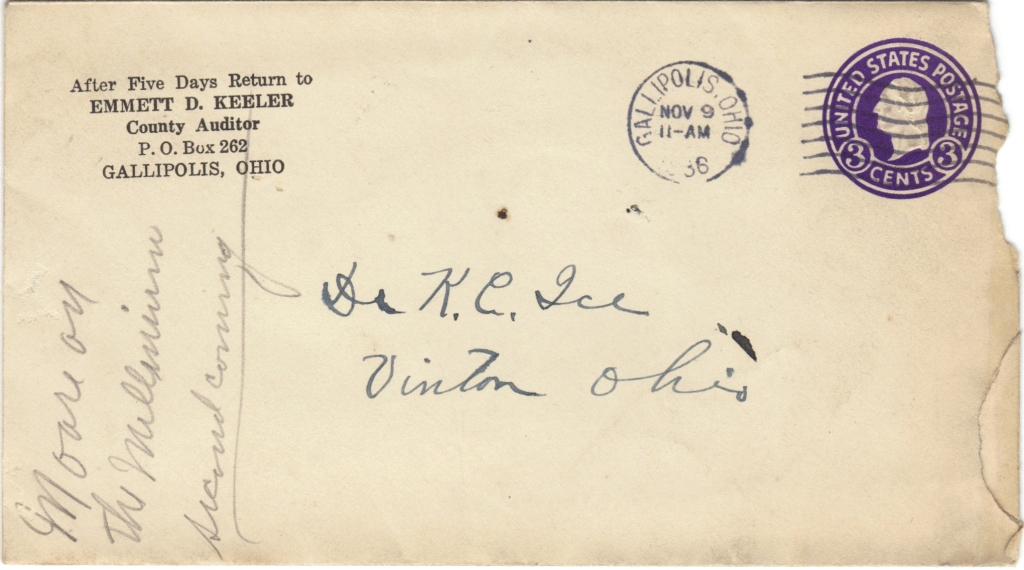
St. Louis College of Physicians and Surgeons, St. Louis, MO
Christian Baptism: A Tract by Isaac Walton Lowman
Four-page, a single sheet folded once, tract entitled “Christian Baptism” by I. W. Lowman. Undated.
I see from the Christian Standard index that Isaac Walton Lowman died in about June or July 1924. One G. Lowman, his child I presume, authored an obituary published in the 19 July 1924 issue of CS at page 1067. Isaac authored 52 obituaries for the pages of Christian Standard from October 1895 through December 1915. CS published one notice of his, of some kind, in 1909. Another about an evangelistic meeting is titled in the index as “Loogootee (Ind.) meeting (from the minister). 1911 1 Ap:542.” Loogootee, Indiana is a new one to me…with a name like that I would surely remember it. Perhaps some Hoosier can comment about Loogootee?
Isaac appears, barely, in Christian-Evangelist. In 1905 he authors “Impression of city campaigns by workers engaged” (page 274) and in 1911 there appears “Our budget” on page 1458. The latter includes a portrait!
Both Christian Standard and Christian-Evangelist carry obituaries of Ellen Frances (Kutzner) Lowman, deceased 1911.
I’ve scoured neither Google nor other print sources for Isaac. I welcome information, though. At present it appears he had an active ministry of some twenty years’ duration, some of it in Loogootee Indiana. Apparently he died after about a ten-year retirement. Where, if anywhere, he matriculated for ministerial preparation remains unknown. What other, if any, publications from his pen saw it through a press remains unknown. Details of the publishing of this tract remain unknown. For all I know Isaac had it worked up by a job printer and used it in that 1911 “city campaign.” How Kromer Columbus Ice got his hands on it, and why he kept it, well…who knows? But he did, and here it is:
Which Church Did Christ Build?: A Tract by John T. Hinds
While I’m thinking about McMechen, I thought I’d post this tract by John T. Hinds. I think it a fair assumption, based on his post-script, that the handwriting on the envelope (the inked address) is Hinds’. K. C. Ice’s hand pencilled the tract’s title on the end of the envelope, as was his preference, for his system of storage and retreival (whatever that was and however it worked for him). If I’m right then this tract pre-dates 1912, as do the other leaflets Hinds mentions in the postscript.
K. C. Ice at McMechen Christian Church, McMechen, WV 1911-1912
In late 1911 Kromer C. Ice, aged 35 and one-half years, began his second stint as pastor at the Christian Church in McMechen, West Virginia. He served McMechen from July 1907 to May 1908, just after graduating from Bethany College as the only student in the Master of Philosophy course, but prior to his marriage to Rosa Birdie Sandidge. By 1911, not only was he married, but they had a toddler. Their son, McGarvey, turned two in October. The Ice’s came back to West Virginia from Powersville, Missouri where KC practiced medicine for a little over one year. Returing to their native West Virginia, they were again close to home and family. What led them to leave is as mysterious as what brought them back.
Kromer kept a skeletal diary of his ministry, recording the amount of his monthly support and the topics, text and titles of sermons preached, and occasional notations of pastoral ministry. Browse the scans and you will see restorations, baptisms and a wedding or funeral or two. As I sift what sermon manuscripts reamin from his years of ministry I might find matches to the list of sermons below. Until then his list will perhaps prove helpful in gaining some insight into how, in the life of one preacher at one church, the text shaped a congregation.
He preserved this account, consisting of about a half-dozen smallish ledger book leaves, held tight by a solitary rusted paper clip, in an envelope marked only ‘McMechen Church Acct.’ Though it is all I have of the McMechen years, it is evidently more than exists anywhere about any of the early McMechen years, period. I post these pages here in hopes that someday someone from McMechen searching for an ancestor might find something. Knowing what it is to search, I’ll do whatever I can to assist fellow seekers.
As I scrutinize his diary I see one fascinating connection…concerning Mrs. J. W. Seibert and John C. Seibert. On 14 April 1912 one Mrs. J. W. Seibert was “fellowshiped in the cong.[regation].” That evening John C. Seibert was “received by confession and baptism.” The following week presumably the same John C. Seibert was “fellowshiped.” I find in Preachers of Today, A Book of Brief Biographical Sketches And Pictures of Living Gospel Preachers (Batsell Barrett Baxter and M. Norvel Young, eds.) 1952, on page 311 in the entry for Charles Austin Siburt this note:
Reared in Christian Church. Family led out of it through personal work of C. D. Plum and debate on Instrumental Music by Foy E. Wallace and Sam P. Jones in Moundsville, W. Va. This year, had opportunity to preach convictions in First Christian Church in Jackson.”
Siburt provides his place of birth as McMechen, W. Va. and date of birth as 17 January 1914. Charles Austin was baptized by Edgar Roy Saum in 1926. In the next volume of Preachers of Today (vol. 2, pp. 400-401) Siburt further indicates his father served as an elder in the Christian Church, but was “converted through debate held by Foy E. Wallace, Jr.”
That Edgar Roy Saum appears twice in the index to Christian Standard indicates to me that in 1926 the Siburt family was still worshipping and serving among the Christian Churches, very likely still in the river town of McMechen, West Virginia. For this reason I conclude the Siburt ‘conversion’ occurred sometime after 1926. Charles Austin Siburt does not mention, though, that he was ever ‘re-baptized.’ I suspect then that his ‘conversion’ was limited to changed convictions about the propriety of instrumental music. Charles Austin Siburt’s son, Charles Austin, Jr. preached for many years and taught at Abilene Christian University. Though I never met Charles, I find our connection in history fascinating and wish we could have connected before his death. It appears my great-grandfather baptized his grandparents (?) and I would like to think helped set them on a path of service among the McMechen church long after his (KCI) ministry came to a close. Through their faith, then, a son and grandson embraced preaching and teaching and through them God only knows how many lives have been touched. I’m assuming that ‘Seibert’ and ‘Siburt’ are one and the same…I think it is at least plausible, if not probable.
I should like to learn more. If so, I’ll post it to this blog.
Ice Family Portrait, ca. 1915
Kromer Columbus Ice holding daughter Areta (b. 1914); Rosa Birdie Sandige Ice holding son McGarvey (b. 1909). About two year after this photo was taken Rosa and the children lived in Shreve, Ohio while First Lieutenant KC Ice tried in vain to save soldiers from epidemic flu in stateside base hospitals. At times he had one orderly to assist. Her raven hair turned white from worrying about him. Overseas orders in hand, he was waiting in Maryland for the next departing ship when the truce was signed ending the war. He resumed his medical practice in small town Jerry City, then Bladensburg, Ohio.
